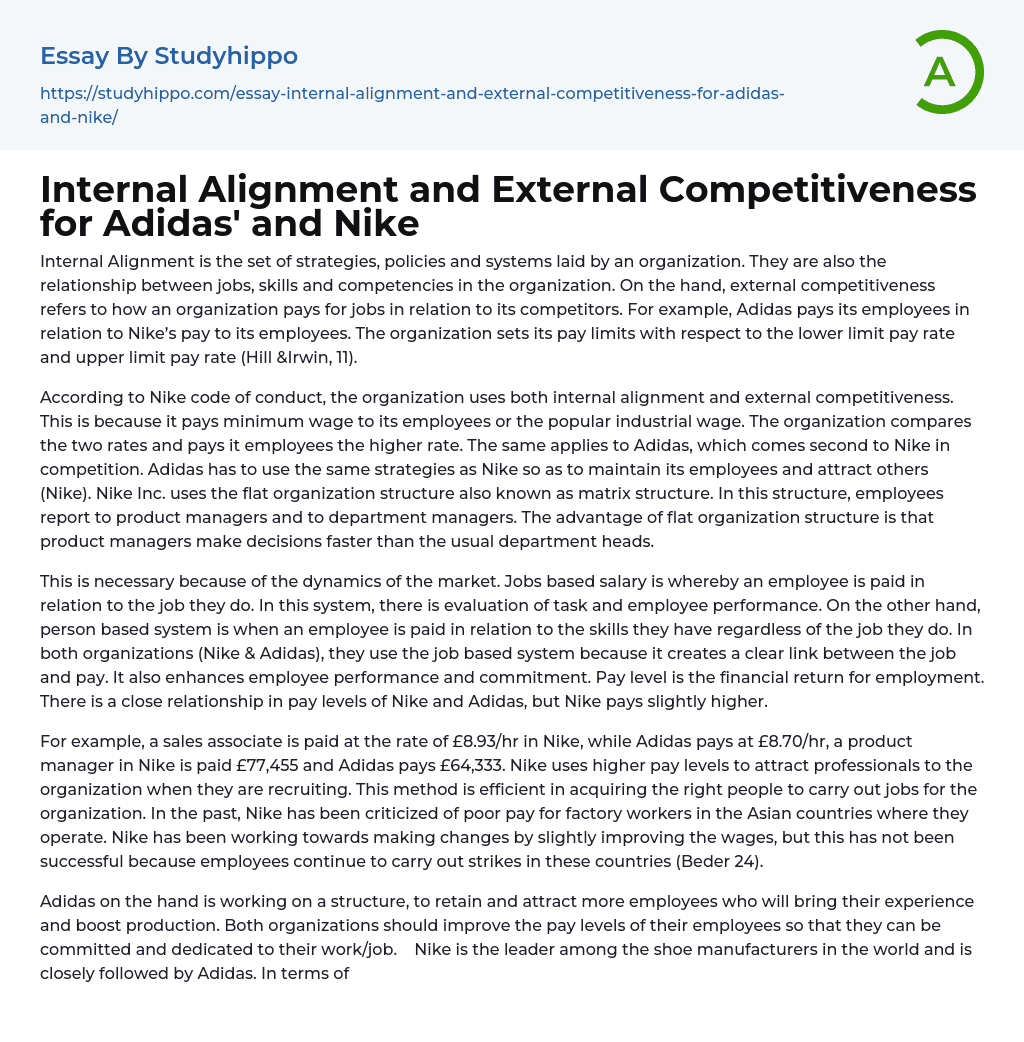

Internal Alignment and External Competitiveness for Adidas’ and Nike Essay Example
Internal Alignment is the set of strategies, policies and systems laid by an organization. They are also the relationship between jobs, skills and competencies in the organization. On the hand, external competitiveness refers to how an organization pays for jobs in relation to its competitors. For example, Adidas pays its employees in relation to Nike’s pay to its employees. The organization sets its pay limits with respect to the lower limit pay rate and upper limit pay rate (Hill &Irwin, 11).
According to Nike code of conduct, the organization uses both internal alignment and external competitiveness. This is because it pays minimum wage to its employees or the popular industrial wage. The organization compares the two rates and pays it employees the higher rate. The same applies to Adidas, w
...hich comes second to Nike in competition. Adidas has to use the same strategies as Nike so as to maintain its employees and attract others (Nike). Nike Inc. uses the flat organization structure also known as matrix structure. In this structure, employees report to product managers and to department managers. The advantage of flat organization structure is that product managers make decisions faster than the usual department heads.
This is necessary because of the dynamics of the market. Jobs based salary is whereby an employee is paid in relation to the job they do. In this system, there is evaluation of task and employee performance. On the other hand, person based system is when an employee is paid in relation to the skills they have regardless of the job they do. In both organizations (Nike & Adidas), they use the job based
system because it creates a clear link between the job and pay. It also enhances employee performance and commitment. Pay level is the financial return for employment. There is a close relationship in pay levels of Nike and Adidas, but Nike pays slightly higher.
For example, a sales associate is paid at the rate of £8.93/hr in Nike, while Adidas pays at £8.70/hr, a product manager in Nike is paid £77,455 and Adidas pays £64,333. Nike uses higher pay levels to attract professionals to the organization when they are recruiting. This method is efficient in acquiring the right people to carry out jobs for the organization. In the past, Nike has been criticized of poor pay for factory workers in the Asian countries where they operate. Nike has been working towards making changes by slightly improving the wages, but this has not been successful because employees continue to carry out strikes in these countries (Beder 24).
Adidas on the hand is working on a structure, to retain and attract more employees who will bring their experience and boost production. Both organizations should improve the pay levels of their employees so that they can be committed and dedicated to their work/job. Nike is the leader among the shoe manufacturers in the world and is closely followed by Adidas. In terms of external competitiveness Nike still leads the pack because it combines both internal alignment and external competitiveness strategies to stay at the top.
It is extremely important for both organizations, to pay employees at the rate that other organizations in the same industry are paying so as to meet its objectives, and
avoid high employee turnover. Nike closed its US factories by 1984 and moved to Asia for cheap labor. When South Korea and Taiwan developed unions they moved to China, Vietnam and Indonesia which were still undeveloped. The same applies to Adidas which was based at Germany now has factories in Asia because of the availability of cheap labour.
These organizations target the countries where there are no strict labor laws and that are less developed. To achieve this, they have to carry out pay surveys to find out how much other industries are paying for similar jobs (Beder, 24). The strategies Nike Inc. uses to stay on top are used by the other companies to challenge it. Nike combines both internal alignment and external competitiveness strategy in employment, and Adidas uses the same strategy to keep up with the competition. The strategy is good; however, Nike as the leader should change its employment policies and improve wages of its employees. This in-turn reflects in other organizations such as Adidas.
- Adidas essays
- Amazon essays
- Apple essays
- Bmw essays
- British Airways essays
- Burger King essays
- Coca-Cola essays
- Company essays
- Costco essays
- Dell essays
- Ebay essays
- Enron essays
- Facebook essays
- Ford Motor Company essays
- Gap essays
- General Motors essays
- Google essays
- Honda essays
- Ibm essays
- Ikea essays
- Intel essays
- Iphone essays
- Johnson and Johnson essays
- Kellogg essays
- Key essays
- Kfc essays
- Mcdonald's essays
- Microsoft essays
- Myspace essays
- Nestle essays
- Netflix essays
- Nike essays
- Nokia essays
- Pepsi essays
- Pepsico essays
- Red Bull essays
- Ryanair essays
- Samsung essays
- Sony essays
- Southwest Airlines essays
- Starbucks essays
- Supermarket essays
- Tesco essays
- Toyota essays
- Twitter essays
- Volkswagen essays
- Walmart essays
- American Dream essays
- Barriers To Entry essays
- Capitalism essays



